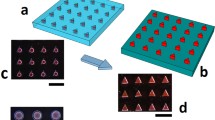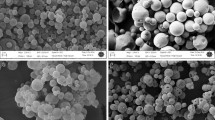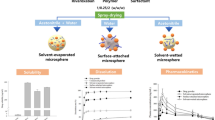Abstract
A method to provide near-constant sustained release of high molecular weight, water-soluble proteins from polyanhydride microspheres is described. The polyanhydrides used were poly (fatty acid dimer) (PFAD), poly(sebacic acid) (PSA), and their copolymers [P(FAD-SA)]. P(FAD-SA) microspheres containing proteins of different molecular sizes—lysozyme, trypsin, heparinase, ovalbumin, albumin, and immunoglobulin—were prepared by a solvent evaporation method using a double emulsion. The microspheres containing proteins were spherical, with diameters of 50–125 µm, and encapsulated more than 80% of the protein, irrespective of the protein used. Enzymatic activity studies showed that encapsulation of enzymes inside polyanhydride microspheres can protect them from activity loss. When not placed inside polyanhydride microspheres, trypsin lost 80% of its activity in solution at 37°C at pH 7.4 in 12 hr, whereas inside the polyanhydride microspheres the activity loss was less than 10% under these conditions. About 47% of the enzymatic activity of heparinase encapsulated in the microspheres was lost at 37°C in 24 hr, while in solution it lost over 90% of its activity. The protein-loaded microspheres displayed near-zero-order erosion kinetics over 5 days as judged by the release of sebacic acid (SA) from the microspheres. The microspheres degraded to form SA and FAD monomers. All proteins were released at a near-constant rate without any large initial burst, irrespective of polymer molecular weight and protein loading. The period of protein release was longer than that of SA and continued protein release was observed even after the microsphere matrix had completely degraded. Differential scanning calorimetric studies demonstrated an interaction between protein and the FAD monomers produced with microsphere degradation. It is likely that the protein interaction with FAD monomers permits formation of water-insoluble protein aggregates which slowly dissolve and diffuse out of the matrix, leading to delayed protein release. For trypsin-loaded microspheres, trypsin lost 40% of its activity during microsphere preparation. Activity studies demonstrated that the sonication process was primarily responsible for activity loss. A reduction in the period of ultrasound exposure decreased the loss of protein activity to around 20%.
Similar content being viewed by others
REFERENCES
W. Sadee. Protein drugs: A revolution in therapy? Pharm. Res. 3:3–6 (1986).
R. Langer. New methods of drug delivery. Science 249:1527–1533 (1990).
R. Langer, D. Lund, K. Leong, and J. Folkman. Controlled release of macromolecules: Biological studies. J. Control. Release 2:331–342 (1985).
R. Bawa, R. A. Siegel, B. Marasca, M. Karel, and R. Langer. An explanation for the controlled release of macromolecules from polymers. 1:259–267 (1985).
S. J. Holland, B. J. Tighe, and P. L. Blound. Polymers for biodegradable medical devices. I. The potential of polymers as controlled macromolecular release systems. J. Control. Res. 4:155–180 (1986).
N. Marcotte and M. F. A. Goosen. Delayed release of water-soluble macromolecules from polylactide pellets. J. Control. Release 9:75–85 (1989).
P. A. Lucas, C. Laurecin, G. T. Syftestad, A. Domb, V. M. Goldberg, A. L. Caplan, and R. Langer. Ectopic induction of cartilage and bone by water-soluble proteins from bovine bone using a polyanhydride delivery vehicle. J. Biomed. Mater. Res. 24:901–911 (1990).
J. H. Eldridge, C. J. Hammond, J. A. Muelbroeck, J. K. Staas, R. M. Gilly, and T. R. Tice. Controlled vaccine release in the gut-associated lymphoid tissues. I. Orally administered biodegradable microspheres target the peyer's patches. J. Control. Release 11:205–214 (1990).
R. Langer and M. Moses. Biocompatible controlled release polymers for delivery of polypeptides and growth factors. J. Cell. Biochem. 45:340–345 (1991).
E. R. Edelman and M. A. Nugent. Controlled release of basic fibroblast growth factor. Drug News Perspect. 4:352–537 (1991).
Y. Tabata and R. Langer. Polyanhydride microspheres that display near-constant release of water-soluble drugs. Pharm Res. (in press).
A. J. Domb and R. Langer. Polyanhydrides. I. Preparation of high molecular weight polyanhydrides. J. Polym. Sci. 25:3373–3386 (1987).
V. C. Yang, H. Bernstein, and R. Langer. Large scale purification of heparinase. Biotechnol. Prog. 3:27–30 (1987).
K. A. Walsh. Trypsinogens and trypsins of various species. Methods Enzymol. 19:41–63 (1970).
R. Langer, R. Linhardt, M. Klein, M. Flanagan, P. Galliher, and C. Cooney. A system of heparin removal. In N. A. Peppas, A. Hoffman, B. Ratner, and S. Cooper (eds.), Biomaterials: Interfacial Phenomena and Applications, Advances in Chemistry Series, Washington, D.C., 1982, pp. 493–502.
E. Mathiowitz and R. Langer. Polyanhydride microspheres as drug carrier. I. Hot-melt microencapsulation. J. Control. Release 5:13–22 (1987).
Y. J. Wang and M. A. Hanson. Parenteral formulation of proteins and peptides: Stability and stabilizers. J. Parent. Sci. Tech. 42(2S):3–26 (1988).
H. Brem, M. S. Mahaley, Jr., N. A. Vick, K. L. Black, S. C. Schold, Jr., P. C. Burger, A. H. Friedman, I. S. Ciric, T. W. Eller, J. F. Cozzens, and J. N. Kenealy. Interstitial chemotherapy with drug polymer implants for the treatment of recurrent gliomas. J. Neurosurg. 74:441–446 (1991).
R. Langer. Polymer implants for drug delivery in the brain. J. Control. Release 16:53–60 (1991).
A. Domb, S. Bogdansky, A. Olivi, K. Dudy, C. Dureza, D. Lenartz, M. L. Pinn, O. M. Colvin, and H. Brem. Controlled delivery of water soluble and hydrolytically unstable cancer drugs from polymer implants. Polym. Preprints 32:219–220 (1991).
J. Kost, K. Leong, and R. Langer. Ultrasound-enhanced polymer degradation and release of incorporated substances. Proc. Natl. Acad. Sci. USA 86:7663–7666 (1989).
V. Sluzky, J. A. Tamada, A. M. Klibanov, and R. Langer. Kinetics of insulin aggregation in aqueous solutions upon agitation in the presence of hydrophobic surfaces. Proc. Natl. Acad. Sci. USA 88:9377–9381 (1991).
W. R. Liu, R. Langer, and A. M. Klibanov. Moisture-induced aggregation of lyophilized proteins in the solid state. Biotech. Bioeng. 37:177–184 (1991).
K. S. Suslick. Ultrasound: Its Chemical, Physical, and Biological Effects, VCH, 1988.
R. M. Macleod and F. Dunn. Effects of intense noncavitating ultrasound on selected enzymes. J. Acoust. Soc. Am. 44:932–945 (1968).
R. J. McClure and B. M. Craven. X-ray data for four crystalline forms of serum albumin. J. Mol. Biol. 83:551–555 (1974).
P. D. Boyer, F. G. Lum, G. A. Ballow, J. M. Luck, and R. G. Rice. The combination of fatty acid and related compounds with serum albumin. I. Stabilization against heat denaturation. J. Biol. Chem. 162:181–194 (1946).
Author information
Authors and Affiliations
Rights and permissions
About this article
Cite this article
Tabata, Y., Gutta, S. & Langer, R. Controlled Delivery Systems for Proteins Using Polyanhydride Microspheres. Pharm Res 10, 487–496 (1993). https://doi.org/10.1023/A:1018929531410
Issue Date:
DOI: https://doi.org/10.1023/A:1018929531410




